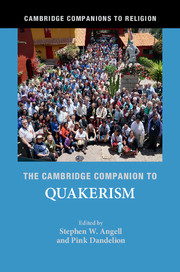Book contents
- The Cambridge Companion to Quakerism
- Cambridge Companions to Religion
- The Cambridge Companion to Quakerism
- Copyright page
- Dedication
- Contents
- Contributors
- Introduction
- Part I History of Quaker Faith and Practice
- 1 History of Quaker Faith and Practice: 1650–1808
- 2 Conflict and Transformation, 1808–1920
- 3 Global Quakerism 1920–2015
- Part II Expressions of Quaker Faith
- Part III Regional Studies
- Part IV Emerging Spiritualities
- References
- Index
- Cambridge Companions to Religion (continued from page ii)
- References
2 - Conflict and Transformation, 1808–1920
from Part I - History of Quaker Faith and Practice
Published online by Cambridge University Press: 06 April 2018
- The Cambridge Companion to Quakerism
- Cambridge Companions to Religion
- The Cambridge Companion to Quakerism
- Copyright page
- Dedication
- Contents
- Contributors
- Introduction
- Part I History of Quaker Faith and Practice
- 1 History of Quaker Faith and Practice: 1650–1808
- 2 Conflict and Transformation, 1808–1920
- 3 Global Quakerism 1920–2015
- Part II Expressions of Quaker Faith
- Part III Regional Studies
- Part IV Emerging Spiritualities
- References
- Index
- Cambridge Companions to Religion (continued from page ii)
- References
Summary
- Type
- Chapter
- Information
- The Cambridge Companion to Quakerism , pp. 31 - 48Publisher: Cambridge University PressPrint publication year: 2018



